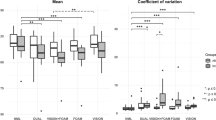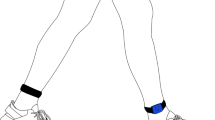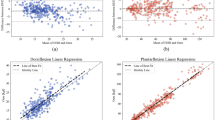Abstract
Study design: Repeated measures design.
Objective: To assess the reliability of a device designed to measure ankle mobility in the clinical setting.
Setting: Spinal Cord Injury Unit, Sydney, Australia.
Methods: Consecutive sample of 15 patients with paraplegia and tetraplegia with injuries of less than 1 year duration was studied. Ankle mobility was measured on two separate occasions 2 or 3 days apart. Stretch torque was standardised and ankle range of motion measured with an inclinometer attached to the footplate. Intraclass correlation coefficients and percent close agreement scores were used to assess agreement between mean measurements obtained on days 1 and 2.
Results: The intraclass correlation coefficient was 0.95 (95% CI, 0.91–0.98). Measurements obtained on day 1 were within 3° of the measurements obtained on day 2 77% of the time and within 6° 97% of the time.
Conclusion: The footplate is a reliable and simple way to measure ankle mobility in people with spinal cord injuries.
Sponsorship: The Motor Accident Authority of NSW
Similar content being viewed by others
Introduction
Limited ankle mobility, in particular limited ankle dorsiflexion, is a common problem associated with spinal cord injury. Physiotherapists administer different types of interventions in an attempt to maintain or increase passive ankle dorsiflexion.1,2,3 It is important that physiotherapists accurately and reliably measure the effect of these interventions. However, treatment effects are likely to be small3 and will not be accurately detected in the presence of large measurement error.4
Typically, clinicians measure ankle mobility by passively dorsiflexing the ankle and using a goniometer to measure the resultant ankle angle.5 Although this technique is widely used by clinicians, it is prone to error because of the inherent difficulties associated with aligning goniometers and ensuring that the dorsiflexion stretch torque applied by the therapist is constant across different testing days.5,6,7,8 The error associated with measurements of this kind is often greater than any real changes in ankle mobility.3,4,9 Researchers have overcome this problem by using instrumented footplates. However, instrumented footplates incorporate force transducers, electric motors and potentiometers, and consequently are too expensive and inconvenient for clinical use. Alternate suggestions have been made for measuring ankle mobility. One technique involves applying a constant stretch torque and measuring ankle angle from photographs.9 While this method of measuring ankle mobility is reliable, it requires two therapists, standardised alignment of a camera and the use of indelible markers. Consequently, it is both time consuming and inconvenient.
The aim of this study was to design and then test a device that could be quickly and easily used by clinicians in their daily practice to measure ankle mobility. The device consists of a footplate attached to a wheel (radius=0.154 m; see Figure 1). The centre of rotation of the footplate and wheel is aligned and the two rotate together. Weights are hung from the rim of the wheel to ensure that a constant torque is applied regardless of ankle stiffness. An inclinometer positioned on the footplate is then used to measure ankle angle.
The instrument used to measure ankle mobility. A bicycle wheel is mounted next to a footplate. A rope then extends from the end of the footplate, around the wheel and over a pulley. The weight is hung from the end of the rope. This in turn rotates the footplate. An inclinometer is then used to measure deviation of the base of the footplate from horizontal
Method
In all, 15 consecutive patients undergoing rehabilitation at a Sydney spinal injury unit were included in this study. A further two eligible patients declined to be involved. Informed consent was attained from all subjects and the authors certify that all applicable institutional and governmental regulations concerning the ethical use of human volunteers were followed during the course of this study. All subjects were currently undergoing rehabilitation and the mean time since injury was 7 months (SD=3 months). In all, 12 subjects' injuries were classified as ASIA A with no motor function or sensation in the lower limbs and the remaining three subjects' injuries were classified as ASIA C or D with varying amounts of lower limb sensation and motor function.10 Two subjects had lower motor neuron lesions with no ankle or knee reflexes. All subjects were male, except one, and the mean age was 36 years (SD=15 years).
Both ankles of all the subjects were tested (30 ankles in total). Repeat measurements were taken 2 or 3 days apart by one of the four therapists. Generally, a different therapist took measurements on days 1 and 2. Therapists measuring on day 2 were not given access to the results of day 1.
Testing on each day followed the same format. Subjects lay supine on a plinth with the knee positioned in extension and the ankle firmly secured in a footplate. A wheel (radius=0.154 m) was mounted on the side of a footplate with its centre aligned with the centre of rotation of the footplate. The footplate and wheel rotated together. A constant ankle dorsiflexion torque was applied by hanging 11 kg from the rim of the wheel. The wheel acted to ensure that the moment arm (ie, radius of the wheel) of the ankle dorsiflexor torque was constant. In this way, the wheel generated a 17 Nm ankle dorsiflexion torque, regardless of ankle stiffness. The stretch torque was maintained for 3 min prior to each measurement to reduce reflex contraction of muscles around the ankle and knee, and to exhaust ‘creep’.
The angle of the footplate in relation to the horizontal position was measured with an inclinometer held on the bottom surface of the footplate. However, footplate angle did not correspond with ankle angle because the tibia was not horizontal. In order to derive ankle angle from footplate angle, the inclination of the tibia was added to footplate measurements. The convention used to report ankle angle was that increases in dorsiflexion accompanied increases in angle.11
Following the first measurement, the stretch torque was removed and the whole procedure (including the 3-min prestretch) was repeated. In this way, two measurements were taken of each ankle on each testing day. The mean of the two measurements was used. An intraclass correlation coefficient (ICC 2,1)12 and percent close agreement of the mean ankle angles attained on the two testing days were then calculated (using SPSS 10.0 for Windows software). Percent close agreement indicates the percentage of pairs of repeat measurements that were within 0, 1, 2, 3, 4 or 5° of each other.
Results
Ankle angle of subjects ranged from 98 to 139° (mean=125°; SD=10). The intraclass correlation coefficient, which describes the degree of agreement of the repeated measures taken over the two testing days, was 0.95 (95% CI, 0.91–0.98), indicating high test–retest reliability. The percent close agreement values are detailed in Figure 2. These indicate that measurements obtained on day 1 were within 3° of the measurement obtained on day 2 77% of the time and within 6° 97% of the time.
Discussion
Plantarflexion contractures of the ankle are a common secondary problem of paralysis associated with spinal cord injury. Various therapeutic techniques are used by physiotherapists to maintain or increase passive ankle dorsiflexion.1,2,3 In an attempt to quantify the success of these interventions therapists routinely measure ankle mobility. This is typically done by measuring passive ankle range of motion with a goniometer. However, the error associated with this technique is often higher than the expected size of any real treatment effect. Alternate and more reliable methods of measuring ankle mobility have been suggested; however, none are sufficiently simple for widespread clinical use.1,5,6,7,8 The device described in this study was designed for this purpose. It is cheap, easy to make and simple to use. The results indicate that therapists can be 77% confident that a 3° change in ankle angle is real and not because of measurement error.
A source of error when measuring passive ankle angle is variation in the applied torque.9 Ankle angle is a function of applied torque. The larger the torque, the greater the angle.3,13,14 The device described in this study uses a wheel attached to a footplate to standardise applied torque. Error is also minimised by eliminating the use of goniometers. Rather, a digital inclinometer held on the bottom flat surface of the footplate is used to measure footplate angle.
The centre of rotation of the footplate is not adjustable and therefore its location does not correspond perfectly with the centre of rotation of subjects' ankle joints. The misalignment of the two centres of rotation is a potential source of error. However, any error introduced by this factor would be consistent across testing days and would not affect reliability. Possibly far greater error would be introduced by attempting to align the centre of rotation of the ankle joint with the device.
A device similar to the one described in this study has been successfully used to construct torque–angle curves of the hip in patients with spinal cord injuries.15 There is no reason that this device could not also be adapted to measure the mobility of other joints and in other patient groups.
Physiotherapists are aware of the need to objectively measure the success of their interventions. However, often the error associated with measurement procedures is greater than treatment effects. The device described in this study is a simple, cheap and reliable way of measuring ankle mobility. The device could be modified and used to measure the mobility of most joints.
References
Moseley AM . The effect of casting combined with stretching on passive ankle dorsiflexion in adults with traumatic head injuries. Phys Ther 1997; 77: 240–247.
Bohannon RW, Larkin PA . Passive ankle dorsiflexion increases in patients after a regimen of tilt table-wedge board standing. Phys Ther 1985; 65: 1676–1678.
Harvey LA, Batty J, Crosbie J, Herbert RD . A randomised trial assessing the effects of 4 weeks of daily stretching on ankle mobility in patients with spinal cord injuries. Arch Phys Med Rehabil 2000; 81: 1340–1347.
Bovens AM et al. Variability and reliability of joint measurements. Am J Sports Med 1990; 18: 58–63.
Pandya S et al. Reliability of goniometric measurements in patients with Duchenne muscular dystrophy. Phys Ther 1985; 65: 1339–1342.
Backer M, Kofoed H . Passive ankle mobility. Clinical measurement compared with radiography. J Bone Joint Surg 1989; 71B: 696–698.
Boone DC et al. Reliability of goniometric measurements. Phys Ther 1978; 58: 1355–1360.
Elveru RA, Rothstein JM, Lamb RL . Goniometric reliability in a clinical setting: subtalar and ankle joint measurements. Phys Ther 1988; 68: 672–677.
Moseley AM, Adams R . Measurement of passive ankle dorsiflexion: procedure and reliability. Aust J Phys 1991; 37: 175–181.
American Spinal Injury Association. Standards for Neurological Classification of Spinal Injury Patients (revised). ASIA: Chicago 1992.
Surgeons AAO . Joint motion. Method of Measuring and Recording. American Academy of Orthopaedic Surgeons: IL 1965.
Shrout PE, Fleiss JL . Intraclass correlations: uses in assessing rater reliability. Psychiatr Bull 1979; 86: 420–428.
Sinkjaer T, Magnussen I . Passive, intrinsic and reflex-mediated stiffness in the ankle extensors of hemiparetic patients. Brain 1994; 117: 355–363.
Ada L, Vattanasilp W, O'Dwyer NJ, Crosbie J . Does spasticity contribute to walking dysfunction after stroke? J Neurol Neurosurg Psychiatry 1998; 64: 628–635.
Harvey L, McQuade L, Hawthorne S, Byak A . Quantifying the magnitude of torque physiotherapists apply when stretching the hamstring muscles of people with a spinal cord injury. Arch Phys Med Rehabil (in press).
Acknowledgements
Special thanks to the clients of the Moorong Spinal Injury Unit for their time and cooperation, Dr Tom Gwinn and Dr Robert Herbert for input into the design of the device, Gerlinde Goehl for assistance with data collection, Dr James Middleton for editorial comments, and Ian Gothard and the Department of Biomedical Engineering at the Royal Rehabilitation Centre for manufacturing the device. This project was partly funded by the Motor Accident Authority of NSW.
Author information
Authors and Affiliations
Rights and permissions
About this article
Cite this article
Harvey, L., Byak, A., Ostrovskaya, M. et al. Reliability of a device designed to measure ankle mobility. Spinal Cord 41, 559–562 (2003). https://doi.org/10.1038/sj.sc.3101486
Published:
Issue Date:
DOI: https://doi.org/10.1038/sj.sc.3101486





